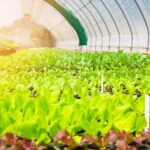Are you a beginner gardener looking to start growing your own vegetables? Learning how to grow vegetables can be a rewarding and enjoyable hobby for beginners. In this article, we will explore the benefits of growing your own vegetables and provide a comprehensive guide for beginner gardeners.
From choosing the right location and soil to understanding sunlight and watering needs, we will cover everything you need to know to get started. Additionally, we will provide a list of easy-to-grow vegetables suited for beginners, along with tips for planting, caring for, and harvesting your vegetable garden.
Growing vegetables is an excellent hobby for beginner gardeners for several reasons. Not only does it allow you to enjoy fresh produce straight from your garden, but it also provides valuable outdoor exercise and connects you with nature. The satisfaction of watching your plants grow and thrive is unmatched. Whether you have limited space or are simply looking for a new hobby, growing vegetables is a great option for beginners.
Before you dive into gardening, it’s essential to plan and prepare your beginner garden properly. Choosing the right location and soil, understanding sunlight and watering needs, selecting the appropriate vegetables, and learning about common pests and diseases are crucial steps that every beginner gardener should take into consideration.
This article will serve as a comprehensive guide to help you navigate through these initial stages so that you can successfully cultivate your own vegetable garden. Get ready to embark on an exciting journey of starting your very own vegetable garden.
Planning Your Beginner Garden
When planning your beginner garden, choosing the right location and soil is crucial to the success of your vegetable crops. The location of your garden should receive plenty of sunlight, ideally at least 6 hours a day. If you have limited space, consider using containers or raised beds that can be placed in the sunniest spots of your yard or balcony.
Soil Quality and Composition
The soil in your beginner garden should be well-draining yet rich in nutrients. Testing the pH level of your soil can help you determine if any amendments are needed to create an ideal growing environment for your vegetables. Adding compost or organic matter can improve soil texture and fertility, providing a good foundation for your vegetable plants.
Choosing the Right Vegetables for Your Soil and Climate
Different vegetables thrive in different types of soil and climate conditions. For example, root vegetables like carrots and radishes prefer loamy, well-draining soil; while leafy greens such as lettuce and spinach can tolerate slightly more moisture-retentive soil. Researching the specific needs of each vegetable on your list will help you determine if they are suitable for your garden’s location and soil type.
By taking the time to plan and prepare your beginner garden with the right location and soil, you’re setting yourself up for success when it comes to growing good vegetables for beginner gardeners. This initial step is essential in creating a healthy environment for your crops to thrive, allowing you to enjoy a bountiful harvest of fresh, homegrown produce.
Understanding Sunlight and Watering Needs
Sunlight Requirements
When it comes to understanding the sunlight needs of your vegetable garden, it’s important to know that most vegetables require at least 6-8 hours of direct sunlight each day. This means that when planning your beginner garden, you’ll want to choose a location that receives ample sunlight throughout the day.
Take note of any trees or structures that may cast shade on your garden area and plan accordingly. Additionally, consider the angle of the sun throughout the day to ensure that your plants are getting the right amount of light.
Watering Your Garden
Watering is another crucial aspect of caring for your vegetable garden. Different vegetables have different watering needs, but as a general rule, most plants require about 1 inch of water per week. However, it’s important to adjust this based on weather conditions and the specific needs of your plants.
Overwatering can lead to root rot and other issues, while underwatering can cause plants to wilt and become stressed. Make sure to water in the morning or evening to avoid evaporation, and be mindful of any signs that your plants may be getting too much or too little water.
Using Mulch for Moisture Retention
One helpful tip for maintaining proper moisture levels in your vegetable garden is to use mulch. Mulch helps retain moisture in the soil, reducing the need for frequent watering while also preventing weeds from growing. Organic mulches like straw or wood chips can also add nutrients to the soil as they break down over time. By using mulch, beginner gardeners can help their vegetables thrive while minimizing the risk of over or under-watering.
With a better understanding of sunlight and watering needs, beginner gardeners can set themselves up for success as they embark on their vegetable growing journey. By choosing a sunny location, monitoring water levels, and utilizing mulch as needed, you’ll be well on your way to cultivating a successful crop of good vegetables for beginner gardeners in no time.
Easy-to-Grow Vegetables for Beginner Gardeners
Whether you have a green thumb or not, starting a vegetable garden can be an exciting and rewarding experience for beginners. One of the key factors to a successful garden is choosing the right vegetables to grow. There are plenty of good vegetables for beginner gardeners that are easy to grow and maintain, making them perfect for those just starting out.
Some of the best vegetables for beginner gardeners include tomatoes, lettuce, carrots, and bell peppers. These vegetables are relatively low-maintenance and can thrive in various soil and climate conditions, making them ideal for novice gardeners. Additionally, these vegetables can be grown both in traditional garden beds and in containers, providing flexibility for those with limited space.
Another set of good vegetables for beginner gardeners includes green beans, radishes, and zucchini. These veggies are known for their quick growth and high yield, making them gratifying choices for those new to gardening. With proper care and maintenance, beginner gardeners can enjoy a bountiful harvest from these easy-to-grow vegetables.
In addition to the aforementioned vegetables, herbs like basil, mint, and parsley are also great options for beginners. Herbs are not only flavorful additions to meals but they also require minimal effort to grow. By including herbs in your vegetable garden, you can enhance your cooking while gaining valuable experience as a novice gardener. By planting these good vegetables for beginner gardeners in your first vegetable garden, you’ll be on your way to a thriving harvest in no time.
Tips for Planting and Caring for Your Vegetable Garden
When it comes to planting and caring for a beginner vegetable garden, there are several important tips to keep in mind. Here are some essential guidelines to help you get started on the right track:
- Start with healthy soil: Before planting your vegetables, make sure that your garden soil is rich in nutrients and well-draining. You can achieve this by adding compost or organic matter to the soil.
- Choose the right plants: When selecting vegetables for your beginner garden, opt for varieties that are easy to grow and low-maintenance. Some good vegetables for beginner gardeners include tomatoes, lettuce, carrots, radishes, and green beans.
- Follow spacing recommendations: When planting your vegetables, be sure to follow the spacing recommendations on the seed packets or plant labels. Proper spacing will allow your plants to receive adequate sunlight and airflow.
In addition to these tips, it’s also important to provide proper care for your vegetable garden once it’s planted:
- Watering: Be mindful of your vegetable garden’s watering needs, as different plants require different amounts of water. In general, it’s best to water deeply and less frequently, rather than lightly and often.
- Weeding: Regularly remove any weeds that may compete with your vegetable plants for nutrients and resources. This will help ensure that your vegetables have ample space and resources to thrive.
- Fertilizing: Depending on the specific needs of your vegetable plants and the quality of your soil, you may need to fertilize them periodically with a balanced fertilizer.
By following these tips for planting and caring for your vegetable garden, you’ll be well-equipped to nurture a thriving crop of delicious homegrown produce. With patience and attention to detail, you’ll soon be enjoying the satisfaction of harvesting fresh vegetables from your own backyard.
Dealing With Common Pests and Diseases in a Beginner Garden
As a beginner gardener, it’s important to be aware of the common pests and diseases that can affect your vegetable garden. Understanding how to identify and address these issues is crucial for the success of your garden. Here are some tips for dealing with common pests and diseases in your beginner garden:
1. Identify Common Pests: Keep an eye out for common garden pests such as aphids, caterpillars, slugs, and snails. These pests can damage your plants and reduce your harvest. Use organic pest control methods or insecticidal soaps to manage these unwanted visitors without harming beneficial insects.
2. Recognize Plant Diseases: Certain vegetable plants are prone to specific diseases, such as powdery mildew on squash or blight on tomatoes. Look for signs of disease, including yellowing leaves, spots, or wilting. Practice good garden hygiene by removing affected plant parts promptly and avoid working in the garden when plants are wet to prevent the spread of disease.
3. Companion Planting: Some vegetables have natural pest-repelling properties that can help protect other plants in your garden. For example, planting marigolds near your tomatoes can deter nematodes and other harmful insects. Research companion planting methods to help naturally ward off pests and diseases in your beginner garden.
By being proactive and attentive to the health of your vegetable plants, you can effectively manage common pests and diseases in your beginner garden while promoting a thriving, productive growing environment.
Remember that a good vegetables for beginner gardeners should be those that are more resistant to common pests and diseases, making them easier to grow for those new to gardening. With proper care and attention, you can enjoy a bountiful harvest from your starter vegetable garden without much trouble from pesky insects or plant diseases.
Harvesting and Enjoying the Fruits (And Vegetables) of Your Labor
Planting a vegetable garden is a rewarding and fulfilling experience, especially for beginners. Once you have successfully planned, planted, and cared for your garden, the time will come to harvest the fruits (and vegetables) of your labor. This is an exciting time that allows you to enjoy the literal “fruits” of your hard work and dedication. Whether you’re growing tomatoes, cucumbers, or carrots, harvesting your own homegrown produce is a satisfying achievement.
When it comes to harvesting your vegetables, it’s essential to know when they are ready for picking. Different vegetables have different signs that indicate they are ripe and ready to be harvested.
For example, tomatoes should be firm and fully colored when picked, while lettuce can be harvested once the leaves are large enough to eat. Be sure to research the specific harvesting requirements for each vegetable in your garden so that you can enjoy them at their peak flavor.
After harvesting your vegetables, it’s time to savor the delicious flavors of your homegrown produce. Whether you enjoy them in salads, as side dishes, or as ingredients in your favorite recipes, there’s nothing quite like the taste of freshly picked vegetables from your own garden. Not only do homegrown vegetables taste better than store-bought ones, but they are also healthier and free from harmful pesticides and chemicals.
| Vegetable | Harvesting Time |
|---|---|
| Tomatoes | Firm and fully colored |
| Lettuce | Large enough leaves to eat |
| Cucumbers | Firm and bright green in color |
Next Steps
If you’ve successfully grown your first batch of vegetables as a beginner gardener, congratulations. Now that you have the hang of it, you might be eager to expand your garden and try out new vegetables. Whether you want to increase the variety of crops you grow or simply grow more of your favorite vegetables, there are several steps you can take to expand your garden and continue developing your skills as a gardener.
One way to expand your garden is by experimenting with new vegetable varieties. As a beginner gardener, it’s important to choose vegetables that are relatively easy to grow and maintain. Some good vegetables for beginner gardeners looking to expand their garden include carrots, radishes, zucchini, and lettuce. These vegetables are known for being resilient and relatively low-maintenance, making them ideal choices for those looking to branch out into new crops.
In addition to trying new vegetable varieties, you can also consider increasing the size of your garden. This could involve creating additional planting beds, expanding the area dedicated to container gardening, or utilizing vertical gardening techniques.
By increasing the size of your garden, you’ll not only have the opportunity to grow more vegetables but also gain valuable experience in managing a larger growing space. As you continue expanding and experimenting with new vegetables in your garden, remember that every bit of progress is an achievement – so enjoy the process and celebrate each successful harvest.
Conclusion
In conclusion, growing your own vegetables as a beginner gardener can be an incredibly rewarding experience. Not only does it provide you with a sense of accomplishment, but it also allows you to enjoy the literal fruits of your labor. By following the tips and guidelines provided in this article, you can successfully plan, plant, and care for your own vegetable garden.
As you start your journey as a beginner gardener, remember that patience is key. Gardening takes time and effort, but the end result is well worth it. Whether you choose to grow easy-to-care-for vegetables like tomatoes and lettuce or experiment with more challenging plants like peppers and squash, the process of nurturing your garden from seedlings to harvest is both fulfilling and educational.
So if you’re considering starting your own vegetable garden, don’t hesitate any longer. With some basic knowledge about choosing the right location, understanding sunlight and watering needs, and dealing with common pests and diseases, along with a list of good vegetables for beginner gardeners to grow, you are well on your way to enjoying the many benefits of growing your own produce at home. Happy gardening.
Frequently Asked Questions
What Are the Best Vegetables for Beginner Gardeners?
The best vegetables for beginner gardeners are typically those that are low-maintenance and relatively easy to grow. Some popular options include tomatoes, lettuce, zucchini, peppers, and radishes. These vegetables tend to be forgiving of minor mistakes and can thrive in various growing conditions.
What Vegetables Should I Start Growing First?
When starting a vegetable garden, it’s generally recommended to begin with relatively simple crops such as lettuce, radishes, and green beans. These vegetables have shorter growing seasons and are less demanding in terms of soil quality and maintenance. As a result, they offer an excellent introduction to the basics of gardening.
What Are the 10 Easiest Vegetables to Grow?
The 10 easiest vegetables to grow include tomatoes, lettuce, zucchini, radishes, green beans, peas, cucumbers, carrots, bell peppers, and spinach. These vegetables are known for their adaptability and resilience to beginner-level gardening practices. With proper care and attention to sunlight and watering needs, they can provide a bountiful harvest for novice gardeners.

If you’re looking to get into vegetable gardening, or are just looking for some tips on how to make your current garden better, then you’ve come to the right place! My name is Ethel and I have been gardening for years. In this blog, I’m going to share with you some of my best tips on how to create a successful vegetable garden.





